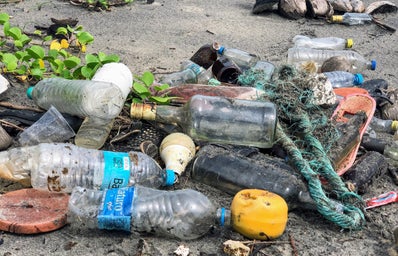For the first time in history, microplastics, which are tiny pieces of plastic debris that come as a result of the disposal of industrial waste, have been found by researchers in the lungs of living humans. According to Britannica, “microplastics are small pieces of plastic, measuring less than 5 [millimeters] in length, that occur in the environment as a consequence of plastic pollution.”
Microplastics have previously posed a major problem in many fields, especially when it comes to aquatic life and the ocean. “Every year, tens of millions of tons of plastic enter Earth’s oceans,” the New York Times says. These microplastics have started to enter deep sea food webs, entering the systems of many, if not most, aquatic animals. Not only do they penetrate into the ocean, but they have also now made their way into living human lungs.
Microplastics, to date, have been detected in human samples from histological lung cancer samples and cadavers as well as human placenta. This raises concern because it shows that particles can travel around the body and may lodge in organs. Researchers with Hull York Medical School and University of Hull in the United Kingdom found that out of their 13 patients, 11 were found with microplastics in their lung tissue samples. “The most common particles were polypropylene, used in plastic packing and pipes, and PET, used in bottles,” said The Guardian. In the past, people have been known to breathe in the tiny particles, as well consuming them via food and water. In the lungs, they found microplastics of size and shape which are inhalable to humans and considerably higher levels of microplastics in male patients as compared with female patients. The types of plastic they found are the kinds most commonly used for soft drink bottles, food packaging and bits of machinery.
In an interview with The Guardian, Laura Sadofsky, a senior author of the study, said, “It is surprising as the airways are smaller in the lower parts of the lungs, and we would have expected particles of these sizes to be filtered out or trapped before getting this deep.” The study uses a spectroscopy, which is used as a tool for studying the structures of atoms and molecules, to identify the type of plastic. According to a scientific study from 2021, “Microplastics can accumulate in the lungs and cause inflammatory and oxidative stress.”
It still remains a very ambiguous and little researched subject, and the effect that microplastics have on the human body is unknown. This is very unsettling due to the potential impacts that the plastic exposure could have on the human body, and more research is being done following this discovery. Workers who are exposed to high levels of microplastics are also known to have developed disease. This recent discovery emphasizes how widespread microplastics have become and how they have invaded every environment they can, even our lungs.
According to Insider, scientists will continue to test human blood, as well as gut and lung tissue, to better understand the impact of microplastic pollution.
Want to see more HCFSU? Be sure to like us onFacebook and follow us on Instagram,Twitter, TikTok, YouTube and Pinterest!


